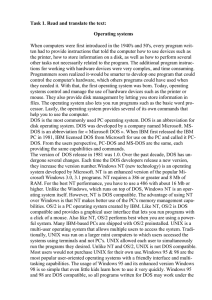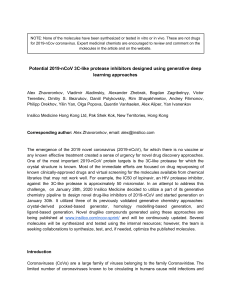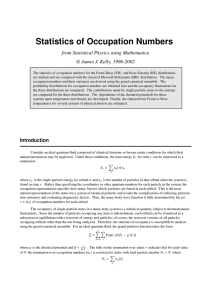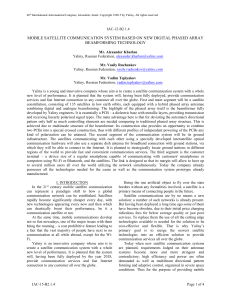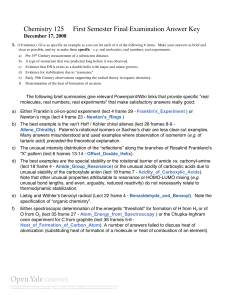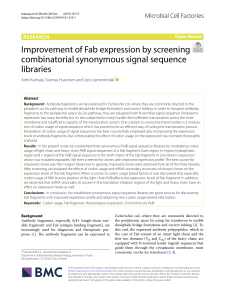TDOS QUANTUM MECHANICAL VISUAL ANALYSIS FOR SINGLE MOLECULES Contreras et al pp 5239 5245 Can J Pure & Appl
реклама
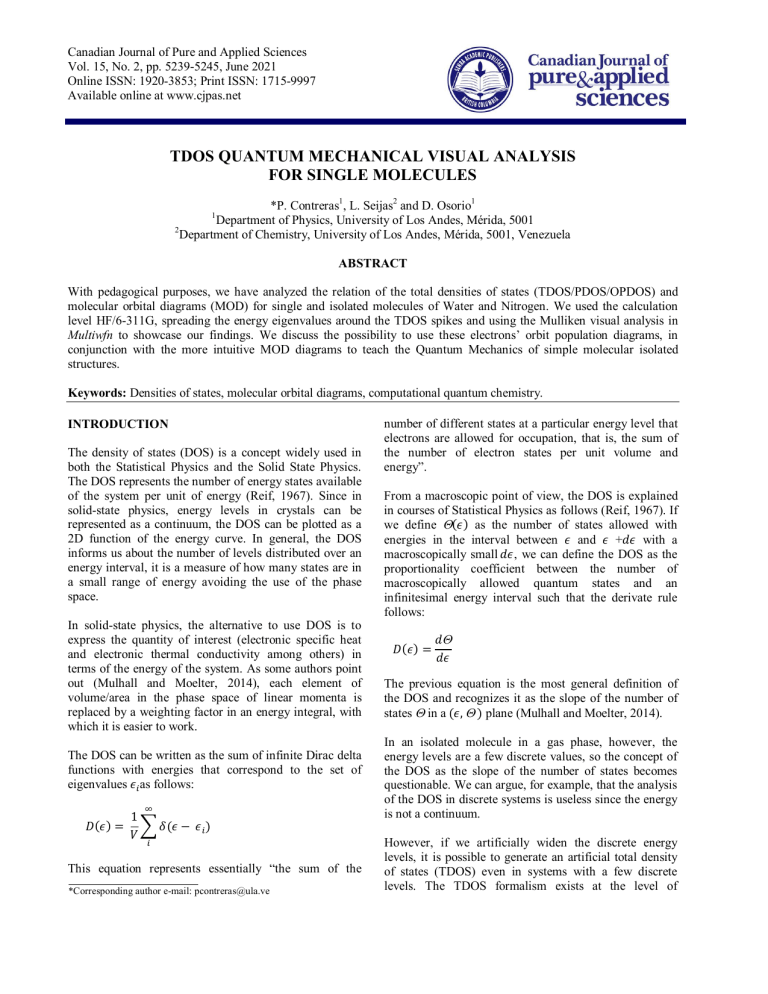
Canadian Journal of Pure and Applied Sciences Vol. 15, No. 2, pp. 5239-5245, June 2021 Online ISSN: 1920-3853; Print ISSN: 1715-9997 Available online at www.cjpas.net TDOS QUANTUM MECHANICAL VISUAL ANALYSIS FOR SINGLE MOLECULES *P. Contreras1, L. Seijas2 and D. Osorio1 Department of Physics, University of Los Andes, Mérida, 5001 2 Department of Chemistry, University of Los Andes, Mérida, 5001, Venezuela 1 ABSTRACT With pedagogical purposes, we have analyzed the relation of the total densities of states (TDOS/PDOS/OPDOS) and molecular orbital diagrams (MOD) for single and isolated molecules of Water and Nitrogen. We used the calculation level HF/6-311G, spreading the energy eigenvalues around the TDOS spikes and using the Mulliken visual analysis in Multiwfn to showcase our findings. We discuss the possibility to use these electrons’ orbit population diagrams, in conjunction with the more intuitive MOD diagrams to teach the Quantum Mechanics of simple molecular isolated structures. Keywords: Densities of states, molecular orbital diagrams, computational quantum chemistry. INTRODUCTION The density of states (DOS) is a concept widely used in both the Statistical Physics and the Solid State Physics. The DOS represents the number of energy states available of the system per unit of energy (Reif, 1967). Since in solid-state physics, energy levels in crystals can be represented as a continuum, the DOS can be plotted as a 2D function of the energy curve. In general, the DOS informs us about the number of levels distributed over an energy interval, it is a measure of how many states are in a small range of energy avoiding the use of the phase space. In solid-state physics, the alternative to use DOS is to express the quantity of interest (electronic specific heat and electronic thermal conductivity among others) in terms of the energy of the system. As some authors point out (Mulhall and Moelter, 2014), each element of volume/area in the phase space of linear momenta is replaced by a weighting factor in an energy integral, with which it is easier to work. The DOS can be written as the sum of infinite Dirac delta functions with energies that correspond to the set of eigenvalues as follows: ( )= 1 ( − number of different states at a particular energy level that electrons are allowed for occupation, that is, the sum of the number of electron states per unit volume and energy”. From a macroscopic point of view, the DOS is explained in courses of Statistical Physics as follows (Reif, 1967). If we define ( ) as the number of states allowed with energies in the interval between and + with a macroscopically small , we can define the DOS as the proportionality coefficient between the number of macroscopically allowed quantum states and an infinitesimal energy interval such that the derivate rule follows: ( )= The previous equation is the most general definition of the DOS and recognizes it as the slope of the number of states in a ( , ) plane (Mulhall and Moelter, 2014). In an isolated molecule in a gas phase, however, the energy levels are a few discrete values, so the concept of the DOS as the slope of the number of states becomes questionable. We can argue, for example, that the analysis of the DOS in discrete systems is useless since the energy is not a continuum. ) This equation represents essentially “the sum of the _____________________________________________________________________ *Corresponding author e-mail: [email protected] However, if we artificially widen the discrete energy levels, it is possible to generate an artificial total density of states (TDOS) even in systems with a few discrete levels. The TDOS formalism exists at the level of 5240 Canadian Journal of Pure and Applied Sciences research and uses a Mulliken atomic fragments type of analysis (Mulliken, 1955). In this formalism, the TDOS represents a DOS curve for the whole system, PDOS nomenclature describes a DOS curve for an atom (or fragment), while OPDOS exhibits a DOS curve for a point (i.e. space-resolved among fragments ‘contribution). Oxygen. H2O contains two σ O-H bonds, it belongs to the C2v symmetry point group. Water, despite being a triatomic molecule, with its chemical bonding scheme is difficult to explain many of its bonding properties. For instance, for the molecule of water, it cannot be explained by one unified bonding model. The curves obtained this way, can be used to interpret and analyze in a quantum mechanics course, the effects of electronic nature in an isolated molecule such as the relationship bonding/TDOS and the type (character) and amount of atomic orbitals involved in molecular fragments’ analysis (Lu and Chen, 2012; Lu, 2017). H2O single gas phase molecule has five occupied and three unoccupied molecular orbitals that can be calculated using the Restricted Hartree-Fock wave function HF/6311G*. Water has a lowest empty molecular orbital (LUMO) formed from the orbital labeled 3a∗, and a highest occupied molecular orbital (HOMO) formed from non-bonding 1b2 orbitals (Haas, 2020. Construct SALCs and the molecular orbital diagram for H2O. Saint Mary's College, Notre Dame. https://chem.libretexts.org). On the other hand, bonding is usually represented by molecular orbital diagrams (MOD). The MODs are a qualitative tool to explain chemical bonding in molecules (Tuckerman, 2020. Linear Combination of Atomic Orbitals. New York University, USA. https://chem.libretexts.org) in terms of the linear combination of atomic orbitals (LCAO). Visually, the MODs are an increasing function of energy-level molecular diagrams for different geometries of simple molecules that help to explain the symmetry properties of each molecule (Machado and Faria, 2018), this technique to teach quantum mechanics of molecules is still widely used in most text books. Our pedagogical idea is shown in Figure 1. We propose that instead of sketching MOD to students, they can get accustomed immediately with the TDOS diagrams to help describe the nature of bonding in molecular systems. We choose for the TDOS analysis two examples: A water nonlinear molecule (H2O) that consists of two atoms of Hydrogen linked by covalent bonds to one atom of In addition, we add a Nitrogen gas phase molecule (N2) which is a linear molecule composed by two atoms of Nitrogen, with its molecular orbitals labeled by its quantum number . The point group for N2 is D∞h. Nitrogen atoms will form three covalent bonds. In addition, it has a LUMO formed from πg* orbitals and an HOMO formed from πu orbitals. TDOS theory for a single molecule In this section, we define the TDOS (Lu, 2017) as follows: ( )= ( − ) If we replace the Dirac function by a broadening function , we obtain a TDOS spread. The function g can be a Fig. 1. The molecular orbital intuitive diagram (MOD) at the left side and the Eigenenergies’ diagram with sketched TDOS/PDOS/OPDOS (right side) and the information attached to this analysis. 5241 Contreras et al. Gaussian, Lorenzian, or pseudo-Voight function. In this way, the normalized Gaussian function is defined as follows (Lu, 2017): ( − )= )= ( − 1 ) + 0.25 ( − ) = + 1− ( − ) ( − In the latter case, since and normalized, the normalization condition of is subject to the value of the weight . ) are It is convenient to define also the projected partial density of states (PDOS) (Mulliken, 1955; Lu and Chen, 2012; Lu, 2017) as the relative contribution of a particular atom/orbital to the TDOS. The overlap population of the partial density of states (OPDOS) is also a weight function that has large positive values at energies where the interaction between two or more species of atoms is a bonding one in a molecule, and negative values where the interaction is an antibonding one. These three functions provide valuable information in the analysis of the orbital composition in a MOD, as we will see from the analysis. The PDOS of a molecular fragment A is defined as: Ξ , ) , ∈ √2 with being the again full width at half maximum, while the pseudo-Voight function is a linear combination of the Gaussian and Lorenzian functions: ( )= , ∈ While the OPDOS between fragments A and B is defined as: 1 where is proportional to the width at the mean height of the function and corresponds to an adjustable parameter within the definition of the broadened density of states. A larger implies that the TDOS graph is smoother, which makes the analysis easier to perform. However, this implies that much of the fine structure is masked, within the TDOS. The Lorenzian function is defined as: ( − Ξ =( ( − ) where corresponds to the composition of fragment in the i-orbital. The composition of each molecular fragment in the i-orbital are defined as in Mulliken, that is: , ( )= ( − , ) where corresponds to the total overlap between , fragments and in the i-orbital and is given by: , = 2( , ∈ , ) , ∈ where finally, the , term corresponds to the overlap integral among different orbitals. Fragment limits and the total overlap have been defined according to the rules in Multiwfn manual section 3.10.3 (Lu, 2017). MATERIALS AND METHODS/COMPUTATIONAL DETAILS For the optimization of the water (H2O) and also nitrogen (N2) molecules, we have used the Gaussian 09 program (Frisch et al., 2003) with the calculation level HF/6311G*. The optimization of the structures was carried out using the Berni algorithm. The cutoff values to consider the convergence were set at 0.000450 a.u. and 0.000300 a.u. for the maximum force and the mean square deviation of the force, respectively. To ensure that the structures corresponded to a minimum energy, a calculation of the vibration frequencies was carried out, verifying that there were no imaginary frequencies. The calculation and visualization of TDOS/PDOS/OPDOS as well as the visualizations of the molecular orbitals were carried out using the Multiwfn program version 3.3.7 (Lu and Chen, 2012). RESULTS AND DISCUSSION To understand what kind of additional information we can get from the artificial TDOS diagram for a single molecule of water (Contreras and Seijas, 2020 https://doi.org/10.13140/RG.2.2.28095.53923), let's consider that for the H2O calculations at the HF/6-311G* level, the wave function obtained corresponds to the ground state, and the orbitals correspond to the canonical molecular orbitals. In this case, we have selected fragment 1 (red color) as being the Oxygen atom (these correspond to the 2p orbitals), fragment 2 (blue color) has been defined as the Hydrogen atoms. The original and expanded densities of states (TDOS, PDOS, and OPDOS) are shown in Figure 2. 5242 Canadian Journal of Pure and Applied Sciences In Figure 2, the left and right axes correspond to the TDOS/PDOS and OPDOS curves, respectively. In addition, the vertical dotted line corresponds to the HOMO. The original TDOS is represented by discrete lines, of which the only accessible information corresponds to those of the electronic levels, in which in addition, it is impossible to distinguish the degeneracy of the energy levels. However, if we broaden the energy levels, starting from the height of the TDOS (black line in Fig. 2), it is possible to know how dense the energy levels are. For the case of the H2O molecule, all levels are equally dense as seen in Figure 2. Furthermore, the broadens that correspond to PDOS (red line for Oxygen/fragment 1, blue line for Hydrogen/fragment 2) and OPDOS (green line) can identify the characteristics of each bond. For example, the red line approximates the TDOS (black curve) in the region of –0.9 to –0.3 a.u., so we can conclude that the oxygen "2p" orbitals have a significant contribution to the corresponding molecular orbitals of the H2O molecule. On the other hand, the OPDOS curve (green line) can be greater or less than zero. The height of the OPDOS indicates how favorable or unfavorable the molecular orbital is informing the chemical bond between the "2p" orbitals of Oxygen and Hydrogen atoms. Finally, in Figure 2, we can see that all orbitals with energies greater than 0.1 a.u. do not lead to the formation of bonds (green curve negative). Fortunately, these orbitals are unoccupied but if the opposite would have happened, the molecule would break. Figure 3 shows the MOs associated with the three energy levels indicated in Figure 1 between –0.9 and –0.3 a.u. In Fig. 2. The Eigenenergy levels in the atomic units [a.u.] with the TDOS (black line), PDOS (red line for fragment 1, blue line for fragment 2) and OPDOS (green line). The three blue arrows 2a, 2b, and 2c indicate the energy levels associated with the MO shown in Figure 3 for H2O, right side scale indicates the OPDOS values. Fig. 3. The Multiwfn visualization of the molecular orbitals for a single molecule of water, as are indicated in Figure 2 (plotted from the 2a, 2b, and 2c Mulliken fragments’ analysis). Contreras et al. Figure 3a, it can be seen that the molecular orbital favors the formation of the chemical bond O-H, since the orbital is located on the Oxygen and Hydrogen atoms, this orbital corresponds to the highest value of OPDOS (insert 2a in Fig. 2). In Figure 3b, we can notice that part of the orbital is centered only on the Oxygen atom. So, we can conclude that its contribution to the formation of the chemical bond is smaller than in the previous case. This is also observed 5243 when examining the height of the OPDOS (the green curve in insert 2b of Fig. 2). Finally, the HOMO orbital is centered only on the Oxygen atom. So, we can conclude that this orbital practically does not contribute at all to the formation of the chemical bond, at this point the OPDOS value is practically zero. The LUMO for H2O is not shown in Figure 3. In Figure 4, we show for H2O the same results shown in Figure 2 but in eV units, since most times the energy eigenvalues are expressed in eV and give a better idea of a TDOS analysis. Fig. 4. The Eigenenergy levels in electron-volt units for a single H2O nonlinear molecule with the TDOS (black line), PDOS (red line for fragment 1, blue line for fragment 2) and OPDOS (green line) Mulliken analysis. The three blue arrows 2a, 2b, and 2c indicate the energy levels associated with the MO, here we use the same scale for TDOS, PDOS, and OPDOS. Therefore, the green curve becomes smaller comparing with the one shown in Figure 2. Fig. 5. The Eigenenergy levels in electron-volt units for a single lineal gas molecule of N2 with the TDOS (red line), PDOS (blue) and OPDOS (green). The arrows 5b and 5c indicate the energy levels associated with the MO shown in Figure 6 for N2, the 5a shows the σ*(2s) orbital. 5244 Canadian Journal of Pure and Applied Sciences Nitrogen molecule The second calculation is for a single molecule of N2 in agas phase. In this case, the wave function obtained corresponds to the ground state of molecular isolated Nitrogen, and the orbitals are the canonical molecular orbitals as well. In Figure 5, the left axes correspond to the TDOS/PDOS and OPDOS curves. In addition, the vertical blue line corresponds to the HOMO πu(2px/y), the vertical cyan line corresponds to the LUMO π*g(2px/y), and the green vertical line corresponds to the σ*(2s) energy level. molecule of N2. To complete the analysis, Figure 6 shows the MOs associated with the two p energy levels that define the gap shown in Figure 4 between –17 eV and 5 eV. The σ*u (2s)MO is not shown in Figure 5. From Figure 6a, it can be seen that the molecular orbital favors the formation of HOMO p N-N bonds. Since the MO are located along both atoms, this MO corresponds to the highest value of the OPDOS. The LUMO antibonding orbital 6b practically does not contribute to the chemical bond, having a negative OPDOS value, it is an empty MO. If we broaden as in the previous case the energy levels for N2 starting from the height of the TDOS (the red line in Fig. 5), it is possible to know the energy levels’ density. The broadens corresponding to the PDOS (blue line for each “2p” orbital) and the OPDOS (green line) identify the characteristics of each bond. In this case from the TDOS/PDOS/OPDOS information analysis, the Nitrogen “2p” orbitals have a significant contribution to the corresponding molecular orbitals. In addition, the height of the OPDOS here also indicates how favorable or unfavorable the molecular orbital is, informing the chemical bond between the "2p" orbitals in a single molecule of N2. In the case of N2, the levels are not equally dense as in the previous case. The level with a higher density corresponds to an Eigenenergy of –16.19 eV. The lowest Eigenenergy is –21.43 eV. The maximum level we show is an empty with 4.99 eV level that corresponds to the LUMO value. The gap between the HOMO and LUMO has an energy of 21.18 eV in a single That is, the overlap population function of the partial density of states (OPDOS) shows that (green curve) is almost zero for the s-occupied level shown in Figure 5a, OPDOS is bigger than zero for the most favorable poccupied level shown in Figure 5b, and OPDOS is smaller than zero for the most unfavorable empty p-high energy level (Fig. 5c). We finally present Table 1 that Fig. 6. The Multiwfn visualization of the molecular orbitals for a single molecule of Nitrogen: (6a) the HOMO and (6b) the LUMO, as are indicated in Figure 5 (plotted from Figs. 5b and 5c TDOS fragments’ analysis). Table 1. The peculiarities of TDOS analysis to understand orbital molecular diagrams respect to the MOD visualization. Visual tools Symmetry picture Eigenvalues Atomic fragment analysis Bonding visualization Analysis of bond types Choice of geometry Linear or nonlinear molecules Shows if the levels are occupied? TDOS analysis No Yes Yes (PDOS, OPDOS) Yes Yes Yes Yes Yes (OPDOS) MOD analysis Yes (Group Theory) No No No Yes Yes Yes Yes 5245 Contreras et al. summarizes the TDOS teachers’ analysis features showcased in this work by comparing with the results of a MOD analysis of several simple single molecular systems (Machado and Faria, 2018). CONCLUSION From the results previously exposed, we conclude that electronic structure calculations can be suited to perform simple isolated molecules MOD analysis for closed shells. A combined single-molecule MOD, TDOS/PDOS/ OPDOS and eigenvalue energy analyses, using the Hartree-Fock HF/6-311G* level, serve a pedagogical purpose in courses of Quantum Mechanics. In particular, we performed a full fragment DOS analysis for single H2O and N2 isolated molecules following the information obtained from the HF solutions. The analysis shows illustrative results linking the energy eigenvalues, the localization of the bonds in the MOD, information from the TDOS energy diagrams such as the overlap orbital contribution to each bond, the gap, LUMO and HOMO orbitals with the visualization tool Multiwfn, and most important, complement the information given by the MOD intuitive diagrams widely used in the classroom literature. The same TDOS analysis can be performed for more complicated magnetic molecules at a different ab initio level of calculation (UDFT/B3LYP level) (Burgos et al., 2017), it can be done for linear or nonlinear molecules that follow LCAO or symmetry adapted linear combinations (SALCs 2020. Symmetry Adapted Linear Combinations. https://chem.libretexts.org). Table 1 in theprevious section summarizes the main findings respect to more popular MOD. ACKNOWLEDGEMENT P. Contreras acknowledges suggestions by Prof. Belkis Ramirez to improve the manuscript from a previous version. This research did not receive any grant from the University of Los Andes or a government organization. REFERENCES Burgos, J., Seijas, L., Contreras, P. and Almeida, R. 2017. On the geometric and magnetic properties of the monomer, dimer and trimer of NiFe2O4. Journal of Computational Methods in Sciences and Engineering. 17(1):19-28. DOI: https://doi.org/10.3233/JCM-160657. Frisch, MJ., Trucks, GW., Schlegel, HB., Scuseria, GE., Robb, MA., Cheeseman, JR., Montgomery (Jr.), JA., Vreven, T., Kudin, KN., Burant, JC., Millam, JM., Iyengar, SS. et al. 2003. Gaussian 03, Revision B. 02. Gaussian, Inc., Pittsburgh PA, USA. Lu, T. 2017. Multiwfn – A multifunctional wave function analyzer – software manual with abundant tutorials and examples. Version 3.4, sections 3 and 4. Beijing Kein Research Center for Natural Sciences, China. https://web.mit.edu/multiwfn_v3.4/Manual_3.4. pdf. Lu, T. and Chen, F. 2012. Multiwfn: A multifunctional wave function analyzer. Journal of Computational Chemistry. 33(5):580-592. DOI: https://doi.org/10.1002/jcc.22885 Machado, SP. and Faria, RB. 2018. Explaining the geometry of simple molecules using molecular orbital energy-level diagrams built by using symmetry principles. Quím. Nova. 41(5):587-593. http://dx.doi.org/10.21577/0100-4042.20170198 Mulhall, D. and Moelter, MJ. 2014. Calculating and visualizing the density of states for simple quantum mechanical systems. American Journal of Physics. 82(7):665-673. DOI: https://doi.org/10.1119/1.4867489 Mulliken, RS. 1955. Electronic population analysis on LCAO-MO molecular wave functions. I. The Journal of Chemical Physics. 23(10):1833-1840. DOI: https://doi.org/10.1063/1.1740588 Reif, F. 1966. Statistical Physics. Berkeley Physics Course. McGraw-Hill, New York, USA. Volume 5. pp. 398. Received: April 30, 2021; Revised: May 7, 2021; Accepted: May 18, 2021 Copyright©2021, Contreras et al. This is an open access article distributed under the Creative Commons Attribution Non Commercial License, which permits unrestricted use, distribution, and reproduction in any medium, provided the original work is properly cited.
